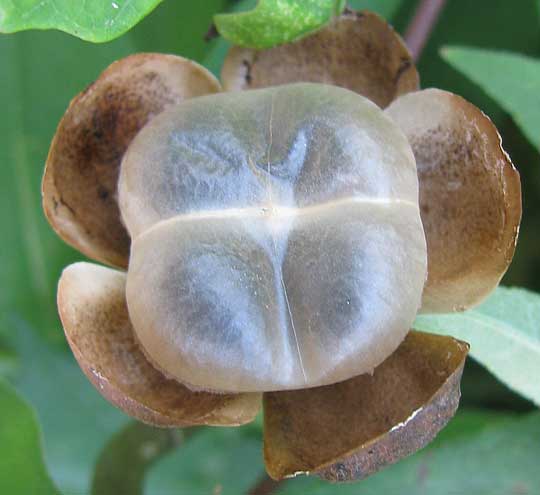Excerpts from Jim Conrad's
Naturalist Newsletter

from the October 10, 2010 Newsletter issued from Hacienda Chichen Resort beside Chichén Itzá Ruins, central Yucatán, MÉXICO; limestone bedrock, elevation ~39m (~128ft), ~N20.676°, ~W88.569°
"ROOSTER FOOT" VINE
We're entering that time of year when morning-glory vines start flowering, and I've never seen anyplace in the world with more morning-glory species than the Yucatán. We must be at or near the morning-glory center of evolution.
This week here and there along roadsides a conspicuous new morning-glory vine has appeared, with large, completely white flowers with spiraling anthers, and broad, deeply lobed leaves, with the lobes spreading like the toes of a chicken's foot. You can see it above.
In that picture notice the deep pits in the flowers' throats, where hummingbird or moths with long proboscises can sup nectar. A close-up showing the unusual spiraling anthers dusted with white pollen, with the spherical, fuzzy-looking stigma atop its long, slender style down at the bottom-left, is shown below:

In Spanish this vine often is called Pata de Gallo, which means "Rooster Foot," because of the leaves' shape. It's OPERCULINA PINNATIFIDA, a species distributed from southern Texas through lowland Mexico into Guatemala.
The fruits are as unusual and interesting looking as the flowers. You can see one subtended by five sepals below:

The bladdery item divided into four compartments is the mature ovary wall, or fruit husk. Inside each of the four cells lies a single large, black, hard seed.
Maximino Martínez's Las Plantas Medicinales de México reports that sometimes hemorrhoid sufferers carry the black seeds in their pockets to ease their pain. This is a good example of the Doctrine of Signatures, which states that medicinal plants may indicate their use by certain signs. In this case I suppose that the sign is the swollen bladder, which somehow is suggestive of what hemorrhoids feel like, even though they don't necessarily look that way.